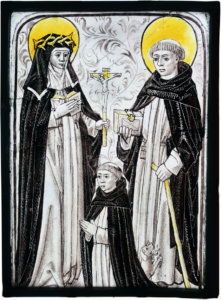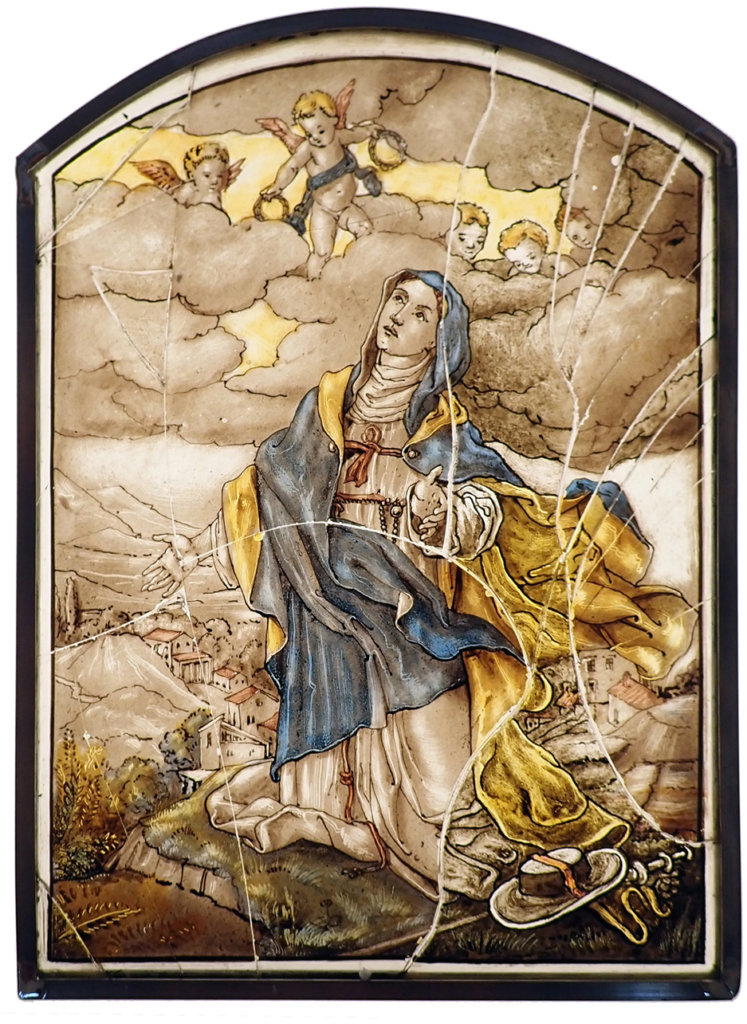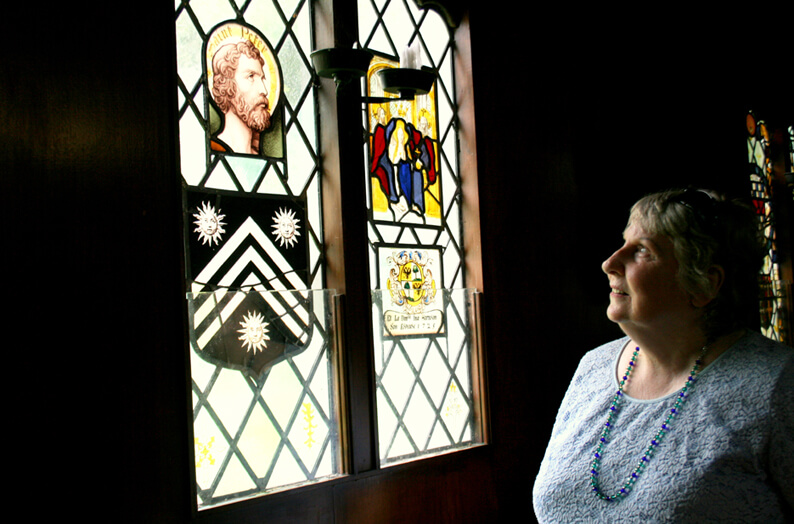
When we explore medieval religious art you could be astonished by the number of objects being held by the figures depicted either in paint or in stained glass windows. Looking at some of the stained glass windows in the Abbey Church there are a number of saints that follow this medieval tradition. They range from serpents to puppy dogs, from skulls to monstrances. Why are they there? What do they mean?

The use of symbols in figurative art began at a time when very few people could read or write, but also when the Church had a huge influence on the population. The introductions of symbols provided an easy form of identification for the onlooker. By incorporating symbols which were well known and associated with saintly men and women, the Church could use the works of art as teaching metaphors for a more spiritual life. These symbols often related to some aspect of the life of the individual depicted which they would have heard many times in sermons from the local bishop or priest. A palm frond told us that the saint had been martyred for their faith and received the ‘palm’ of victory.
Many saints had symbols that are recognizable today – the spiked wheel of St Katherine of Alexandria has transmogrified into the Catherine wheel of fireworks. Poor St Lucy holds a pair of pincers which was the instrument of her torture as does St Lawrence with his gridiron from which, according to Catholic martyrology, he cheerfully asked his tormentors to turn him over as he was toasted on that side – a remarkable statement of fortitude. If the figure holds a crosier (symbolising a shepherd’s crook and relating to Christ as the Good Shepherd) it meant they had been an abbot or an abbess of an abbey, a religious house, where they were supposed to be shepherds of the flock.

In the Abbey Church is a lovely stained glass window of St Hilda, holding a crosier and also a small church building. St Hilda was the founder of the convent at Whitby in England. But in a shield below are three coiled serpents which in fact are ammonites, prehistoric shellfish found in the chalk cliffs of Whitby and believed to have been turned to stone by the saint. St Katherine of Alexandria is always identified by a wheel. History tells us that a wheel was the mode of torture she underwent for not converting to the ancient Roman gods. The fiery St Dominic is always seen with a small dog and legend states that while pregnant with Dominic, his mother had a dream that a dog came from her womb with a flaming torch in its mouth. It is said that she understood the dream as referring to her son Dominic and that he would light the world on fire with the message of the Gospels. He is sometimes called the Hound of God.
For the Abbey Museum’s collection research team an awareness of these symbols is very useful when investigating the historical Christian objects in our collection such as paintings, sculptures and stained glass. But… yes there is a ‘but’…. Sometimes the clues are confusing and an agreement on the identification of the individual depicted in a painting, sculpture or stained glass is hard to reach.

As you may be aware, the Abbey Museum has in its collection a series of medieval and Victorian stained glass windows that have been undergoing conservation. The latest panels, that date from the 16th century and are probably from Germany, depict a musketeer and a female saint named in the original catalogue as St Rosalia. But is it St Rosalia or another female saint, maybe St Rose of Lima. Well to tell the truth, the jury is still out.

Our stained glass panel depicts a kneeling woman in a nun’s habit gazing devoutly heavenward where five putti (or cherubs) descend for the clouds. One holds out two circlets of roses. Below can be seen a small village in a country setting with poplar trees and mountains. On the ground beside where she is kneeling is a flat hat partially covering what seems to be a sword or as has also been suggested a walking staff. The window is made in wonderful muted colours of pinks, greys and blues.
So who was St Rosalia and does the iconography in our stained glass panel fit the accepted symbology used to depict this renowned Sicilian saint. Rosalia was born to a noble family in Palermo in the Kingdom of Sicily in 1130. She was said to have been devoutly religious. At an early age and wanting to devote her life to God she became a hermit in a cave on Mount Pellegrino to which tradition says that she was led by two angels. She would remain there until her death at the young age of 36 in 1166. She is credited after her death with having saving the city from a terrible plague. Fortunately a talented artist, Anthony van Dyck, was staying in Palermo at the time and in thankfulness for his deliverance from the plague, painted several masterpieces of the saint.
Traditionally Rosalia is depicted as a young Rubenesque woman with long flowing hair and wearing a circlet of roses. Sometimes she is shown holding a cross, book, or skull, and also a spray of lilies. Other images have her holding a chisel and hammer with which she is said to have carved a dedication into the wall of her cave. She is commonly depicted attended by winged angels, and often with a view through a cave opening of Palermo Harbour.
So how does this description correlate with our panel?
- Her depiction as a young woman with long flowing hair and wearing a circlet of roses. In our panel she wears a nun’s habit.
- She is shown holding a cross, book, or skull, and also a spray of lilies – none of these symbols are seen in our panel.
- Rosalia is commonly depicted attended by winged angels. At last, yes there are five angels peeking out of heaven with one potentially bringing to her circlets of flowers (potentially roses).
- She is often depicted with a view through a cave opening of Palermo Harbour – in our panel there is a small town seen in the distance but it seems to be a country scene and unfortunately it is not clear enough to see if it is indeed a harbour town. And there is no cave in sight.
- In our panel there is a flat hat and possibly a sword or maybe a walking staff. What might these indicate? Rosalia was not known to have gone on any pilgrimages, although her cave became a pilgrimage site once it was discovered more than 300 years after her death. However, legend has it that at the age of 14, Rosalia escaped her father’s castle escorted by two angels; one disguised as a knight and the other as a pilgrim. Could the hat and the sword be a reference to this incident?
If her habit was another colour she could be St Therese of Avila, and there is a current thought that she may be St Rose of Lima. So are we ready to rule on the case of the unidentified female saint?? Well no, not yet. In this case, as you can tell, the evidence is confusing and nothing is clear cut. The research goes on and until we can say undeniably who the window depicts she is registered as the unknown female saint.
Visit the Abbey Museum to see our wonderful collection of historical stained glass. Tours of the windows in the Abbey Church are on Tuesdays and Thursdays at 11.00 am.


